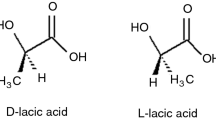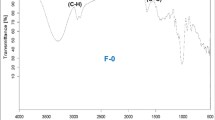Abstract
Both hydroscopic materials and phase change materials represent popular research topics. This paper proposes PEG polymers as endothermal-hydroscopic materials adjusting the temperature and humidity of an environment. A homogeneous PEG mixture with different water contents is prepared via a mutual diffusion methodology in a high-temperature environment. The as-prepared mixture is characterized by X-ray diffraction (XRD), scanning electron microscopy (SEM), differential scanning calorimetry (DSC) and isothermal adsorption. The XRD and SEM results indicate that the crystallinity decreases as the moisture content increases, and the primary particles disappear. According to the DSC results, both the phase transition temperature and latent heat exhibit a negative linear relationship with the water content. Isothermal adsorption curves indicate that water molecules uniformly dispersed in the polymer can optimize its microstructure, providing a mass transfer channel for water vapour. Additionally, PEG2000 exhibits the best endothermal-hydroscopic performance. The PEG2000 phase transition temperature and latent heat decrease by 6.7 °C and 28.9 J g−1, respectively, when a 10 % liquid is added to the polymer. The D-value (change value) is clearly lower than those of PEG4000 (10.9 °C and 36.9 J g−1) and PEG8000 (10.1 °C and 55.2 J g−1). In addition, the PEG2000 water uptake is 198 g kg−1 for 6 h.









Similar content being viewed by others
References
Hong Y, Ge XS. Preparation of polyethylene–paraffin compound as a form-stable solid–liquid phase change material. Sol Energy Mater Sol C. 2000;64(1):37–44.
Yuan YP, Zhang N, Tao W, Cao XL, He Y. Fatty acids as phase change materials: a review. Renew Sustain Energy Rev. 2014;29:482–98.
Yang X, Yuan Y, Zhang N, Cao X, Liu C. Preparation and properties of myristic–palmitic–stearic acid/expanded graphite composites as phase change materials for energy storage. Sol Energy. 2014;99:259–66.
Lane GA. Phase change materials for energy storage nucleation to prevent supercooling. Sol Energy Mater Sol C. 1992;27(2):135–60.
Ryu HW, Woo SW, Shin BC, Kim SD. Prevention of supercooling and stabilization of inorganic salt hydrates as latent heat storage materials. Sol Energy Mater Sol C. 1992;27(2):161–72.
Kenisarin M, Mahkamov K. Solar energy storage using phase change materials. Renew Sustain Energy Rev. 2007;11(9):1913–65.
Zeng JL, Cao Z, Yang DW. Effects of MWNTs on phase change enthalpy and thermal conductivity of a solid–liquid organic PCM. J Therm Anal Calorim. 2009;95(2):507–12.
Zhang N, Yuan YP, Wang X, Cao XL, Yang X, Hu S. Preparation and characterization of lauric–myristic–palmitic acid ternary eutectic mixtures/expanded graphite composite phase change material for thermal energy storage. Chem Eng J. 2013;231:214–9.
Arundel AV, Sterling EM, Biggin JH, Sterling TD. Indirect health effects of relative humidity in indoor environments. Environ Health Perspect. 1986;65:351.
Korsgaard J. House-dust mites and absolute indoor humidity. Allergy. 1983;38(2):85–92.
Bind MA, Zanobetti A, Gasparrini A. Effects of temperature and relative humidity on DNA methylation. Epidemiology. 2014;25(4):561 (Cambridge, Mass.).
Zhang HQ, Yuan YP, Zhang N, Cao XL. Inorganic composite adsorbent CaCl2/MWNT for water vapor adsorption. RSC Adv. 2015;5(48):38630–9.
Spiridon M, Hauta OR, Secula MS, Petrescu S. Preparation and characterization of some porous composite materials for water vapor adsorption. Rev Chim. 2012;63(7):711–4.
Yuan YP, Zhang HQ, Yang F, Zhang N, Cao XL. Inorganic composite sorbents for water vapor sorption: a research progress. Renew Sustain Energy Rev. 2016;54:761–76.
Chen HJ, Cui Q, Tang Y, Chen XJ, Yao HQ. Attapulgite based LiCl composite adsorbents for cooling and air conditioning applications. Appl Therm Eng. 2008;28(17):2187–93.
Simonova IA, Freni A, Restuccia G, Aristov YI. Water sorption on composite “silica modified by calcium nitrate”. Microporous Mesoporous Mater. 2009;122(1):223–8.
Chen Z, Su D, Qin M, Fang G. Preparation and characteristics of composite phase change material (CPCM) with SiO2 and diatomite as endothermal-hydroscopic material. Energy Build. 2015;86:1–6.
Shang JL, Ni B. Prepared of sepiolite phase change material and study on their thermal and moisture performance. Non Met Mines. 2014;37(3):5–7.
Sharma R, Ganesan P, Tyagi V, Mahlia T. Accelerated thermal cycle and chemical stability testing of polyethylene glycol (PEG) 6000 for solar thermal energy storage. Sol Energy Mater Sol C. 2016;147:235–9.
Xiong W, Chen Y, Hao M. Facile synthesis of PEG based shape-stabilized phase change materials and their photo-thermal energy conversion. Appl Therm Eng. 2015;91:630–7.
Qi GQ, Yang J, Bao RY. Enhanced comprehensive performance of polyethylene glycol based phase change material with hybrid graphene nanomaterials for thermal energy storage. Carbon. 2015;88:196–205.
Alkan C, Günther E, Hiebler S, Himpel M. Complexing blends of polyacrylic acid-polyethylene glycol and poly (ethylene-co-acrylic acid)-polyethylene glycol as shape stabilized phase change materials. Energy Convers Manag. 2012;64:364–70.
Feng L, Zheng J, Yang H, Guo Y, Li W, Li X. Preparation and characterization of polyethylene glycol/active carbon composites as shape-stabilized phase change materials. Sol Energy Mater Sol C. 2011;95(2):644–50.
Tan B, Huang Z, Yin Z. Preparation and thermal properties of shape-stabilized composite phase change materials based on polyethylene glycol and porous carbon prepared from potato. RSC Adv. 2016;6(19):15821–30.
Tang B, Qiu M, Zhang S. Thermal conductivity enhancement of PEG/SiO2 composite PCM by in situ Cu doping. Sol Energy Mater Sol C. 2012;105:242–8.
Sarı A. Composites of polyethylene glycol (PEG600) with gypsum and natural clay as new kinds of building PCMs for low temperature-thermal energy storage. Build Environ. 2014;69:184–92.
Karaman S, Karaipekli A, Sarı A, Bicer A. Polyethylene glycol (PEG)/diatomite composite as a novel form-stable phase change material for thermal energy storage. Sol Energy Mater Sol C. 2011;95(7):1647–53.
Wang J, Yang M, Lu Y. Surface functionalization engineering driven crystallization behaviour of polyethylene glycol confined in mesoporous silica for shape-stabilized phase change materials. Nano Energy. 2016;19:78–87.
Acknowledgements
We thank the Program of Ministry of Education of China for Natural Science Foundation of China (No: 51378426) and the Youth Science and Technology Innovation Team of Sichuan Province of Building Environment and Energy Efficiency (No: 2015TD0015).
Author information
Authors and Affiliations
Corresponding author
Rights and permissions
About this article
Cite this article
Yuan, Y., Zhang, H., Zhang, N. et al. Effect of water content on the phase transition temperature, latent heat and water uptake of PEG polymers acting as endothermal-hydroscopic materials. J Therm Anal Calorim 126, 699–708 (2016). https://doi.org/10.1007/s10973-016-5537-0
Received:
Accepted:
Published:
Issue Date:
DOI: https://doi.org/10.1007/s10973-016-5537-0




